In the realm of software architecture, the choice between monolithic and microservices approaches is deciding on a foundation for your digital ambitions. Monolithic architecture offers cohesion and simplicity, while microservices emphasize flexibility and scalability.
In this article, we embark on a journey to dissect these contrasting paradigms, providing insights to guide your architectural decisions and illuminate the path to efficient development.
Monolithic vs. Microservices Architecture: Advantages & Disadvantages
Monolithic and microservice architecture represent two fundamentally different approaches to software development, each with its own set of advantages and drawbacks. Understanding these characteristics is key to making informed decisions when designing and building your applications.
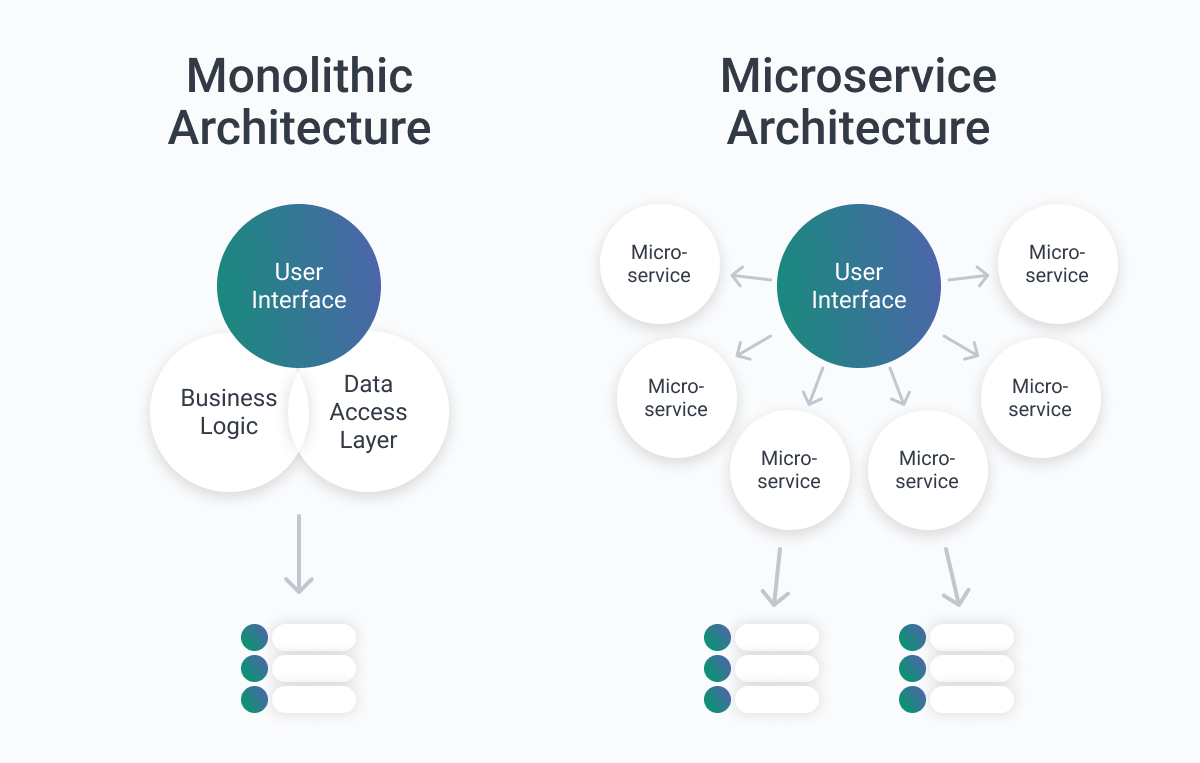
Understanding Monolith Architecture
Monolithic Definition
In the world of software architecture, the term "monolithic" refers to an architectural approach where an entire application is developed as a single, self-contained unit. In this setup, all components and modules of the application are tightly integrated, forming a cohesive structure where code, data, and functionality are interconnected within a single codebase.
Pros of a Monolithic Application
-
Simplicity: Monolith architecture is generally simpler to develop and manage because everything is contained within a single codebase. This simplicity often translates to faster development times and easier debugging.
-
Tight Integration: The close coupling of components in a monolith servers allows for efficient sharing of data and functionality. This can lead to faster data access and better performance in certain scenarios.
-
Efficiency: Monolithic architectures typically require fewer communication overheads compared to distributed systems. This efficiency can result in lower resource utilization and reduced latency in some cases.
Cons of Monolith Architecture
-
Scalability Challenges: Scaling a monolithic application can be challenging because you often need to scale the entire application even if only a specific component requires additional resources. This can lead to inefficiencies and increased costs.
-
Limited Technology Choices: In a monolithic architecture, all components use the same technology stack. This limits your ability to choose different technologies or frameworks for different parts of the application, potentially hindering innovation.
-
Maintenance Complexity: Making updates or bug fixes in a monolithic system can be challenging. Changes to one part of the application may have unintended consequences elsewhere, making it more difficult to maintain and evolve over time.
Understanding Microservices Architecture Pros and Cons
Microservices Definition
Microservices architecture is a modern approach to software development that emphasizes breaking down a complex application into smaller, independent services. Each of these services is responsible for a specific piece of functionality and operates as a separate, autonomous unit. These services can communicate with each other through well-defined APIs.
Advantages of Microservices Software Architecture
-
Scalability: Microservices allow individual components to be scaled independently. This fine-grained scalability enables better resource utilization and cost efficiency, as you can allocate resources where they are needed most.
-
Flexibility: Developers have the freedom to choose different technologies, frameworks, and programming languages for each microservice. This flexibility enables you to select the best tool for the job, enhancing adaptability.
-
Maintenance Ease: Updates, bug fixes, and feature enhancements can be applied to specific microservices without affecting the entire application. This reduces the risk of unintended consequences and accelerates the development cycle.
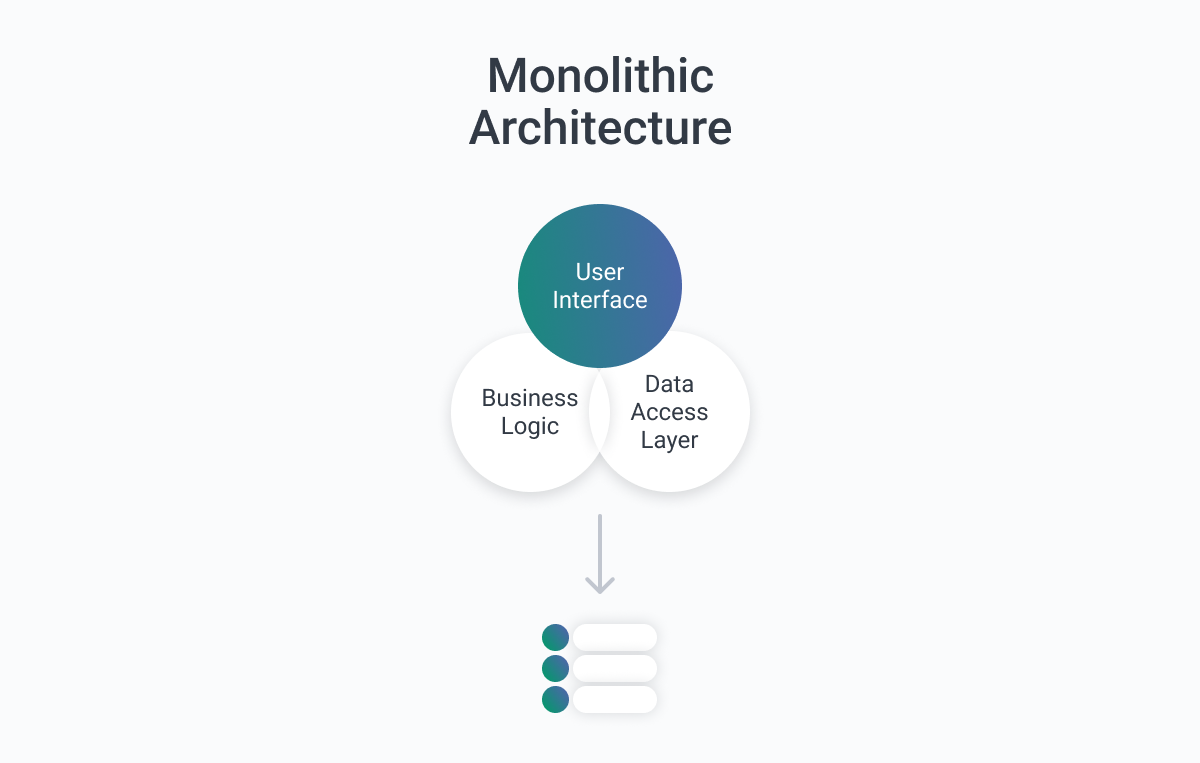
Cons of Microservices Architecture
-
Complexity: Managing a large number of microservices can introduce a higher level of complexity, especially in terms of deployment, monitoring, and debugging. Effective governance is crucial to mitigate this challenge.
-
Coordination and Communication: As microservices operate independently, effective coordination and communication between teams responsible for different services are essential. This can require additional effort in terms of integration and collaboration.
-
Infrastructure Requirements: Microservices often demand a more robust infrastructure to handle the distributed nature of services, adding complexity to your technology stack and potentially increasing operational costs.
Key Difference Between Microservices and Monolithic Software
At the core of the comparison between microservices and monolithic architecture are their foundational principles, which shape the entire development approach. Monolithic software revolves around the concept of a single, all-encompassing application unit where all components are closely intertwined within a unified codebase. On the other hand, microservices architecture embraces modularity and decentralization, advocating for the division of an application into smaller, loosely coupled services.
Understanding Microservices vs Monolithic Architecture:
In monolithic architecture, an application functions as a monolith – a singular, self-contained entity. All aspects of the application, including code, data, and functionality, are tightly integrated, simplifying development and reducing the overhead associated with communication between components. This approach is renowned for its simplicity and streamlined development processes. However, it exhibits limitations when it comes to scalability, adaptability, and the freedom to choose diverse technologies for different parts of the application.
The opposite of a monolithic system is microservices architecture - in contrast, promotes the dissection of a complex application into individual, autonomous services. Each of these services is responsible for a specific function, operating independently and communicating with others through well-defined APIs.
This modularity grants developers unparalleled scalability, flexibility, and ease of maintenance. Each microservice can be developed, deployed, and scaled independently, allowing for resource allocation precisely where needed.
This flexibility extends to technology choices, enabling the selection of the most suitable tools for each service's unique requirements. While offering these advantages, microservices introduce complexities in terms of management, coordination, and infrastructure demands, which must be carefully addressed.
Understanding these fundamental disparities is pivotal in determining which architectural approach aligns best with your project's objectives and constraints, as they profoundly influence the development, scalability, and maintainability of your software application.
Differences Between Monolithic vs Microservices
| Aspect | Monolithic Architecture | Microservices Architecture |
|---|---|---|
| Deployment | One large unit deployment | Independent service deployments |
| Scalability | Challenging to scale parts | Easy scaling of specific services |
| Development | Slower due to coordination | Faster with smaller teams |
| Maintenance | Complex, affects whole app | Easier, localized changes |
| Performance | Impact from resource-heavy | Optimized, improved per service |
| Testing | Complex, interconnected | Easier, independent testing |
| Resource Utilization | May consume more resources | Efficient resource use |
| Versioning | Whole app versioning | Flexible per-service versions |
| DevOps Integration | Complex CI/CD pipelines | Simplified CI/CD for services |
Monitoring Microservices
Monitoring microservices presents unique challenges due to the distributed nature of this architecture. Traditional monolithic applications have the advantage of centralized monitoring, but in a microservices environment, you must adopt a different strategy.
Effective monitoring involves tracking the performance, health, and interactions of individual services. To achieve this, specialized tools and practices, such as container orchestration platforms, log aggregation, and distributed tracing, are essential.
These tools provide insights into service-specific issues, latency bottlenecks, and the overall health of your microservices ecosystem. By implementing comprehensive monitoring, you can quickly identify and address performance bottlenecks, errors, and anomalies, ensuring the reliability of your microservices-based application.
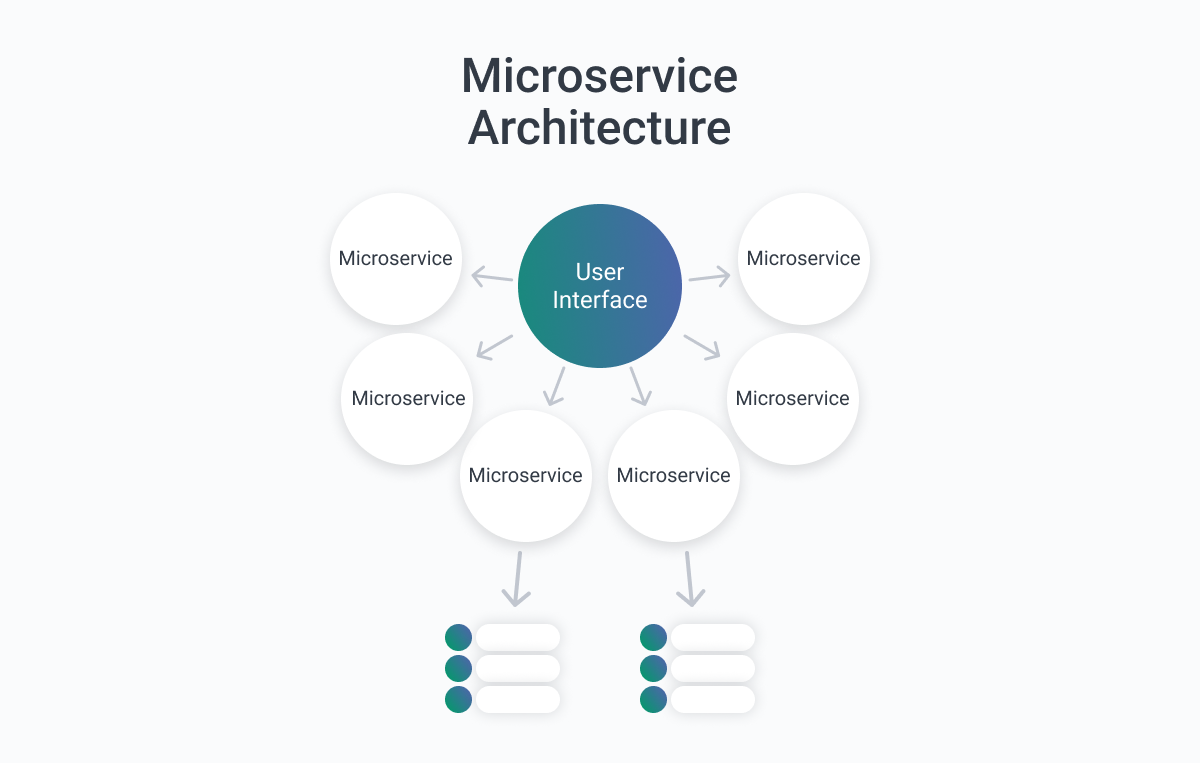
Development Process
The development process in microservices architecture differs significantly from the monolithic approach. In a microservices environment, development teams are often organized around specific services, fostering a more focused and specialized approach to coding. Each team takes ownership of one or more microservices, allowing for independent development, testing, and deployment.
Continuous integration and continuous delivery (CI/CD) pipelines are essential to ensure seamless and rapid deployments of microservices. Microservices also encourage a more diverse technology stack since each service can be built using the most suitable tools and languages for its purpose.
However, coordinating multiple teams and services requires effective communication, collaboration, and integration strategies to maintain cohesion across the entire application.
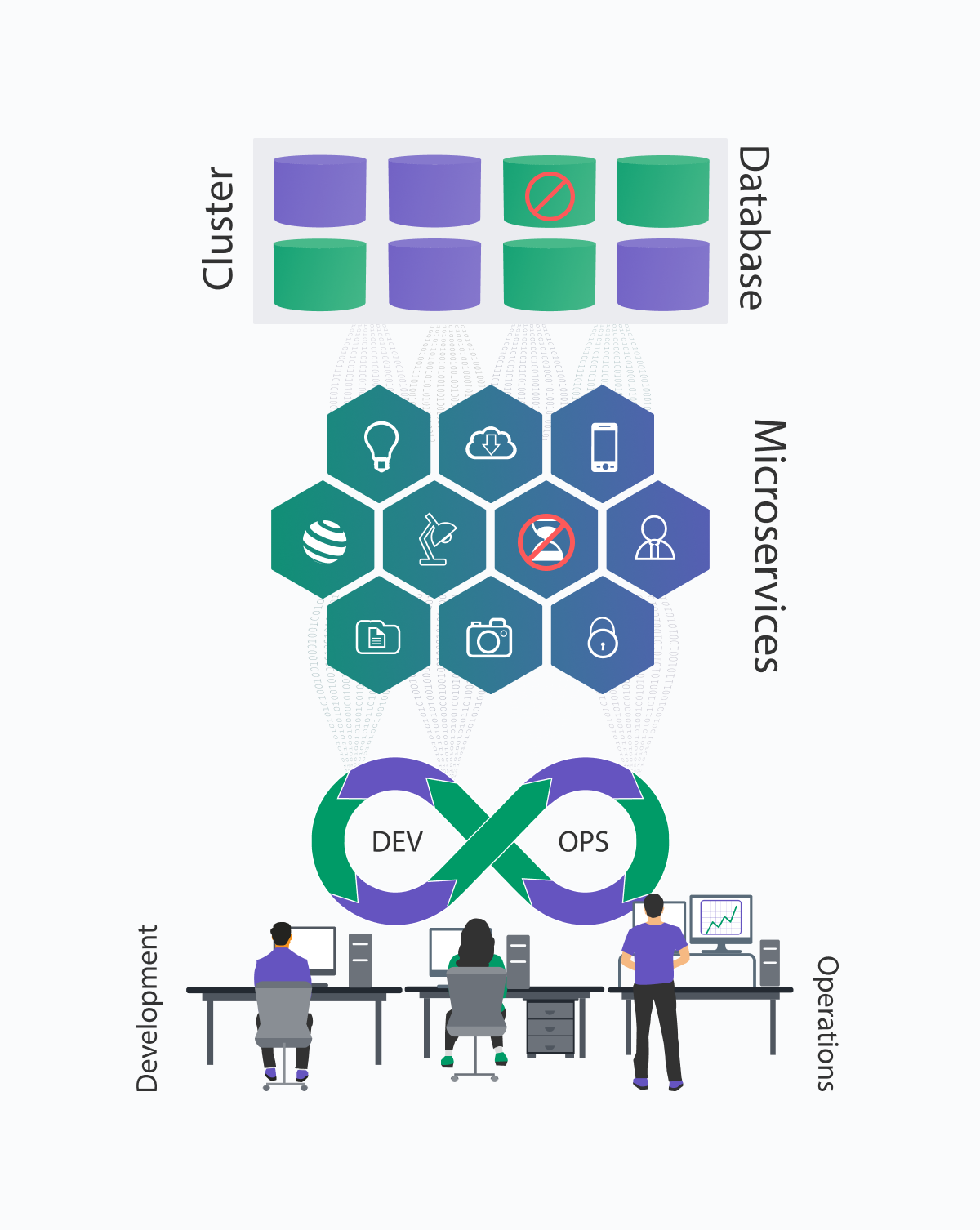
Scalability and Flexibility
Scalability and flexibility are two areas where microservices architecture shines. Microservices can be scaled independently, allowing you to allocate resources precisely where needed, resulting in efficient resource utilization and cost savings. This dynamic scalability is crucial for handling variable workloads and responding to increased user demand.
Furthermore, microservices offer unparalleled flexibility in technology selection. Each service can use the most appropriate tools and frameworks for its specific requirements, promoting innovation and adaptability. This flexibility allows you to evolve and update individual services without affecting the entire application, facilitating a more agile development process.
Deployment and Maintenance
Deploying and maintaining microservices can be complex due to the decentralized nature of the architecture. Each service requires its own deployment and scaling strategy. Containerization technologies like Docker and orchestration platforms such as Kubernetes have become essential for managing the deployment of microservices.
They enable automated scaling, load balancing, and efficient resource allocation. Maintenance in a microservices environment is more granular and manageable compared to monolithic applications. Updates, bug fixes, and enhancements can be applied to individual services without disrupting the entire application.
However, this granularity also means you need robust monitoring, version control, and rollback mechanisms to ensure the reliability and consistency of your microservices ecosystem. Effective management tools and practices are crucial to streamline deployment and maintenance processes.
Choosing the Right Architecture for Your Project: Monolithic and Microservices
Selecting the appropriate architecture for your software project is a critical decision that can significantly impact its success. Whether you opt for a monolithic or microservices approach, understanding your project's unique requirements and constraints is essential.
To make an informed choice, consider factors such as the project's complexity, scalability needs, development team size, and long-term objectives. Evaluating these aspects will guide you toward the architecture that aligns best with your project's goals and ensures efficient development, deployment, and maintenance.
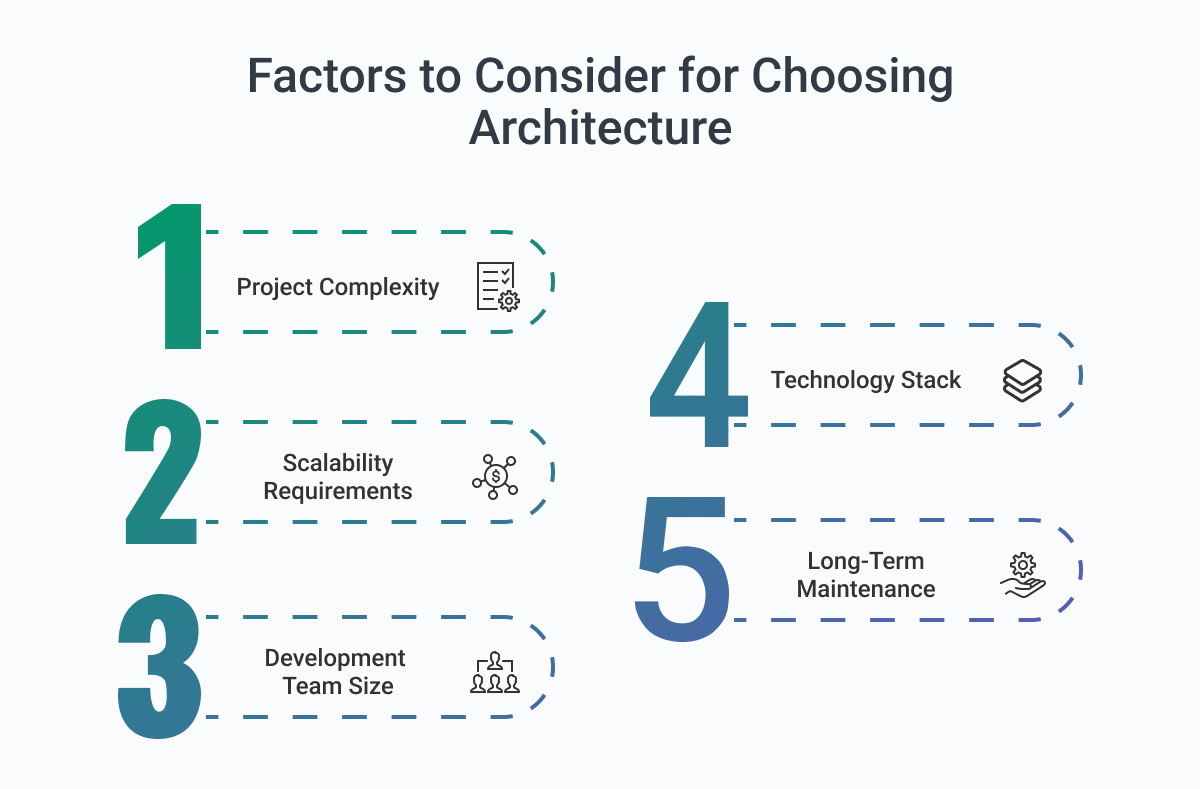
Factors to Consider for a Switch to Microservices
Several key factors should influence your choice of architecture:
-
Project Complexity: Assess the complexity of your project. Monolithic architectures are often suitable for simpler applications, while microservices shine in complex, large-scale systems with multiple independent functionalities.
-
Scalability Requirements: Determine your scalability needs. If your application must handle varying workloads and rapid growth, microservices offer more granular scalability options.
-
Development Team Size: Consider the size and composition of your development team. Smaller teams may find it easier to manage a monolithic codebase, while larger teams can benefit from the modularity of microservices.
-
Technology Stack: Evaluate whether your project requires a diverse technology stack. Microservices allow for technology flexibility, while monolithic architectures are constrained to a single technology stack.
-
Long-Term Maintenance: Think about long-term maintenance. Microservices offer easier updates and maintenance of individual components, reducing the risk of disruptive changes.
Which Architecture is the Best Fit for Your Business?
The choice between monolithic and microservices architecture should align with your solution's specific needs and your business goals. Consider your project's complexity, scalability demands, development team capabilities, and long-term maintenance requirements.
Additionally, consider requesting microservices consulting services to help make your decision and see if microservices might be the right fit. Keep in mind that hybrid approaches, combining elements of both architectures, are also viable options for some projects.
If you're ready to make a well-informed architectural decision for your software project - Softjourn is here to provide expert guidance. Contact us today to ensure that your solution precisely aligns with your distinct needs and strategic business objectives.
Ultimately, the selected architecture should empower your team to deliver a robust and scalable solution that meets your business objectives while maintaining the agility to adapt to evolving needs and technologies.

Use Cases and Examples
To further illustrate the decision-making process, consider these use cases and examples:
-
Financial Services Application: A financial services application dealing with complex transactions and compliance requirements might opt for microservices to ensure modularity, scalability, and agility in adapting to changing regulations.
- Ticketing Platform: In a monolithic architecture, the entire ticketing platform is developed as a single, cohesive unit. All components, from event listing to ticket sales and management, are tightly integrated within a single codebase. On the other hand, microservices architecture shines in larger platforms with diverse functionalities, offering scalability, flexibility, and streamlined maintenance.
- E-commerce Platform: An e-commerce platform with various functionalities like user management, inventory management, and order processing could benefit from microservices. Each functionality can be developed as a separate service, allowing for scalability and independent updates.
Migrating from Monolithic to Microservices Architecture
Transitioning from a monolithic architecture to a microservices architecture is a strategic move that can greatly enhance the scalability, flexibility, and maintainability of your software. However, migrations are a complex process that requires careful planning, execution, and a deep understanding of how your existing application is built.
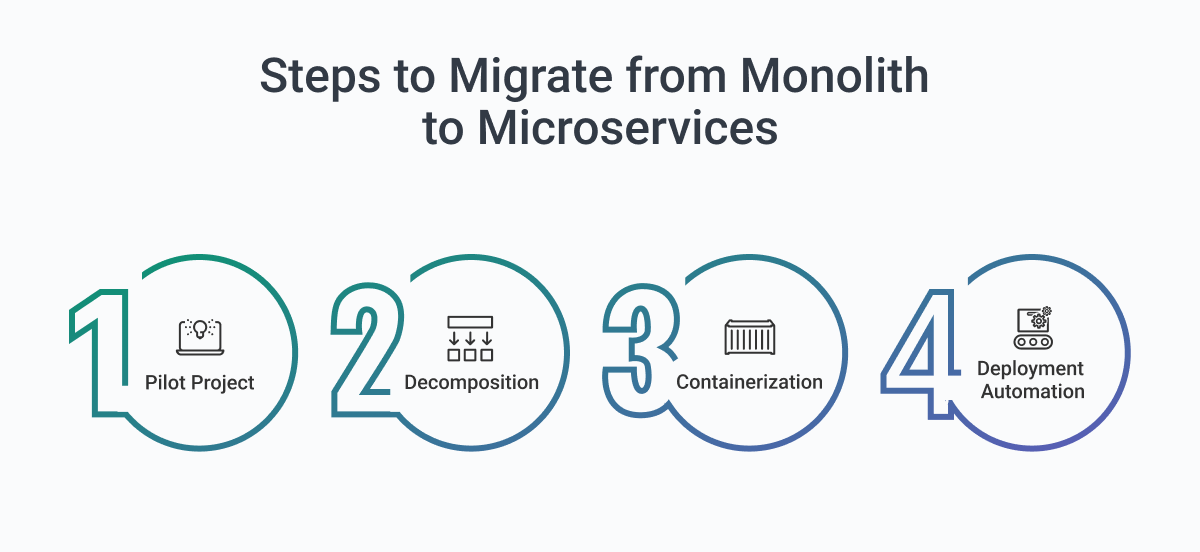
Planning the Migration from Monolith to Microservices
-
Assessment: Begin by conducting a comprehensive assessment of your current monolithic system. Identify the components, dependencies, and functionalities that can be decoupled and transformed into microservices. Consult with a third-party provider or in-house team to assess the scalability and performance bottlenecks in your existing architecture.
-
Service Identification: Determine the boundaries of your future microservices. This involves defining clear service boundaries, data flow, and communication protocols between services. Focus on creating services that align with your business goals and can be independently developed and maintained.
-
Data Management: Address data storage and management. Decide whether to maintain a shared database or opt for separate databases for each microservice. Consider data migration strategies and data consistency in a distributed environment.
Step-by-Step Process
-
Pilot Project: Start with a pilot project or a specific module of your application. This allows you to test the microservices architecture on a smaller scale, refine your approach, and build familiarity within your development team.
-
Decomposition: Begin decomposing your monolith into microservices. This may involve breaking down functionalities, extracting code, and creating independent services. Ensure seamless communication between these services using APIs or messaging systems.
-
Containerization: Embrace containerization technologies like Docker to encapsulate each microservice and its dependencies. Container orchestration tools such as Kubernetes can help manage the deployment and scaling of microservices.
-
Deployment Automation: Implement robust CI/CD pipelines for automated deployment, testing, and monitoring of microservices. Automation ensures a smooth transition and minimizes deployment-related risks.
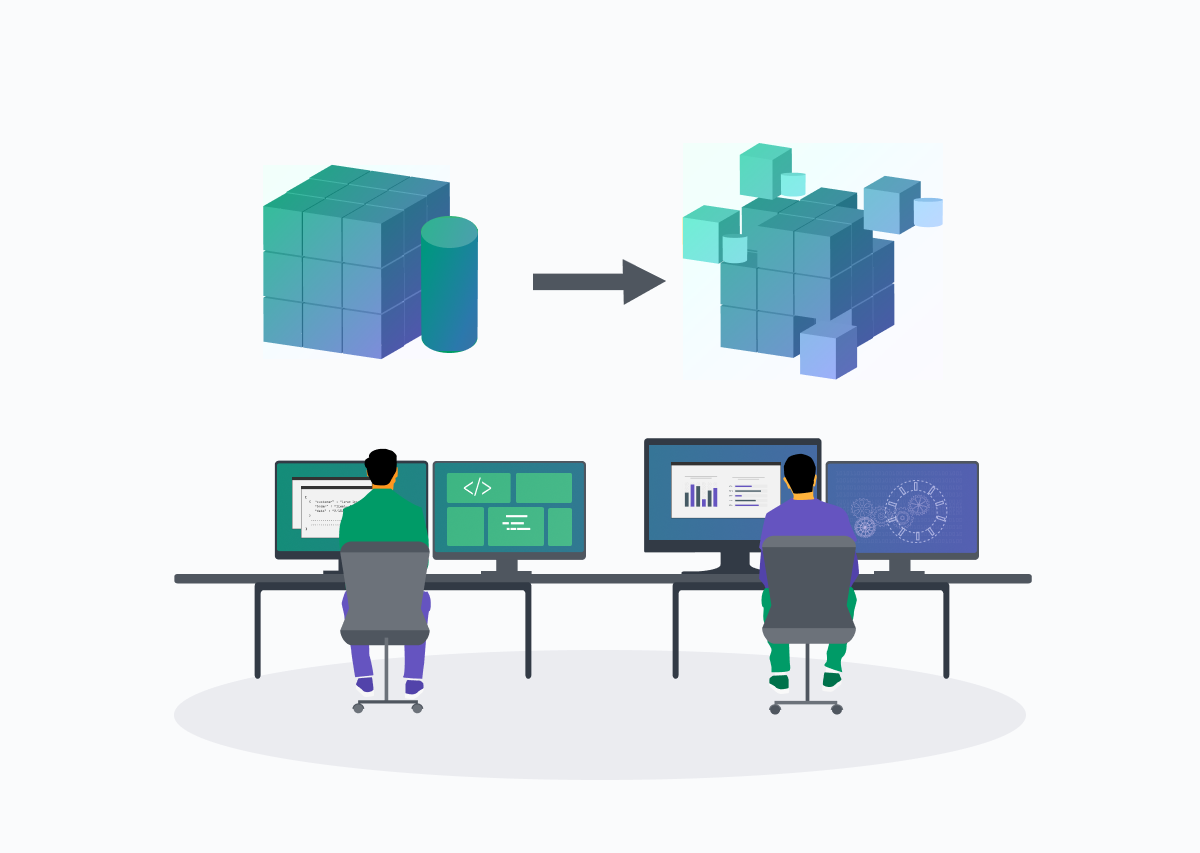
Challenges and Best Practices
-
Testing: Rigorous testing is crucial. Develop comprehensive test suites for each microservice, including unit tests, integration tests, and end-to-end tests. Implement testing practices that ensure data consistency and fault tolerance.
-
Monitoring and Debugging: Invest in monitoring and logging solutions to gain insights into the performance and health of microservices. Establish effective debugging practices to quickly identify and resolve issues in a distributed environment.
-
Security: Pay special attention to security. Implement authentication, authorization, and encryption mechanisms to protect data and prevent unauthorized access between microservices.
-
Team Collaboration: Foster collaboration and communication among development teams responsible for different microservices. Establish clear ownership and responsibilities for each service.
-
Documentation: Maintain thorough documentation for each microservice, including APIs, dependencies, and data schemas. Documentation helps onboard new team members and ensures transparency.
Migrating from monolith to microservices architecture is a significant undertaking, but with meticulous planning, a gradual approach, a trusted software development partner, and adherence to best practices, you can unlock the benefits of increased scalability, flexibility, and maintainability for your whole application.

The Future of Software Development: Monolith vs Microservices and Beyond
The future of software development is a landscape characterized by innovation, new features, adaptability, and scalability, with microservices architecture at its core. As technology continues to evolve, so do the demands of modern applications and the need for rapid development and deployment.
Microservices provide the foundation for building flexible, resilient, and highly scalable software systems that can meet these evolving demands. However, the future goes beyond microservices alone. It encompasses the integration of emerging technologies such as serverless computing, containerization, and artificial intelligence.
This dynamic landscape promises to reshape the way we conceive, build, and deliver software, ushering in an era of unprecedented efficiency and innovation.
Final Word: The Difference Between Monolithic and Microservices
The choice between monolithic vs microservices architectures is a pivotal decision that significantly influences the success of a software project. The decision should align with the project's complexity, scalability needs, and long-term maintenance requirements.
As technology continues to evolve, embracing the future of software development may involve integrating emerging technologies such as serverless computing, containerization, and artificial intelligence. Ultimately, the selected architecture should empower teams to deliver robust and scalable solutions while maintaining the agility to adapt to evolving needs and technologies.
FAQ
Q: What is the difference between monolithic and microservices architecture?
A: Microservices and monolithic architecture are two opposite approaches to building applications. Monolithic architecture refers to building an application as a single, large, and cohesive unit, where all components are tightly integrated. On the other hand, microservices architecture involves breaking down the application into smaller, loosely coupled services that can be developed, deployed, and scaled independently.
Q: When should I choose monolithic vs microservices architecture?
A: Choose monolithic architecture for simple projects with limited resources, a single technology stack, and the need for rapid development. On the other hand, microservices architecture is typically recommended when you have a complex and large-scale application with multiple independent functionalities. It is suitable for projects that require flexibility, scalability, and the ability to update or replace individual services without affecting the entire application.
Q: What are the benefits of using microservices?
A: Some benefits of using microservices include:
- Scalability: Microservices allow individual components to be scaled independently, enabling better performance and resource utilization.
- Flexibility: With microservices, developers can choose different technologies and frameworks for each service, based on specific requirements.
- Maintenance: Updates and bug fixes can be applied to specific services without impacting the entire application.
- Resilience: Fault isolation is easier in microservices architecture, as failures in one service are less likely to affect others.
Q: Can I switch from a monolithic architecture to microservices?
A: Yes, it is possible to migrate from a monolithic architecture to microservices. However, the process requires careful planning and consideration of various aspects, such as identifying service boundaries, rearchitecting the application, handling data storage and communication between services, and managing the deployment and monitoring of microservices.
Q: What are the challenges of adopting a microservices architecture?
A: Some challenges of adopting a microservices architecture include:
- Complexity: Microservices introduce a higher level of complexity due to the increased number of services and their interactions.
- Management: Managing and coordinating a large number of services can be challenging, particularly when it comes to deployment, monitoring, and debugging.
- Infrastructure: Microservices architecture requires a robust infrastructure to handle the distributed nature of the services.
- Development Team: Building and maintaining a distributed team capable of developing and managing microservices can be a challenge.
Q: What is serverless architecture and how does it relate to microservices?
A: Serverless architecture is a cloud computing execution model where the cloud provider dynamically manages the allocation and provisioning of resources, removing the need for developers to manage the underlying infrastructure. While serverless architecture is not the same as microservices, they can be used together. Microservices can be deployed in a serverless environment, taking advantage of its scalability and pay-as-you-go pricing model.
Q: What are the pros and cons of monolithic architecture vs other options?
A: Some pros and cons of monolithic architecture include:
- Pros:
- Simplicity: Monolithic architecture is simpler to develop and deploy compared to microservices.
- Tight Integration: All components are tightly integrated, making it easier to share data and functionality.
- Efficiency: Monolithic architecture requires fewer communication overheads compared to distributed systems.
- Cons:
- Scalability: Scaling a monolithic application may require scaling the entire application rather than specific components.
- Flexibility: Technology choices and updates are limited, as all components use the same technology stack.
- Maintenance: Bug fixes or updates can be challenging as any change may affect the entire application.
Q: How does microservices architecture address the limitations of monolithic architecture?
A: Microservices architecture addresses the limitations of monolithic architecture by:
- Scalability: Services can be scaled independently, allowing for better resource utilization and cost efficiency.
- Flexibility: Choosing different technologies and frameworks for each service allows for greater flexibility and adaptability.
- Maintenance: Updates and fixes can be applied to specific services without affecting the entire application, reducing the impact of changes.
- Resilience: Fault isolation is easier, as failures in one service are less likely to affect the entire application.
Q: What are the characteristics of a microservice?
A: Some characteristics of a microservice include:
- Modularity: Microservices focus on small and independent components that can be developed and maintained separately.
- API-driven: Each microservice exposes a well-defined API for communication and interaction with other services.
- Decentralized data management: Each microservice may have its own dedicated database or use a loosely coupled data storage approach.
- Autonomous: Microservices are designed to be self-contained and independent, allowing for individual deployment and scalability.
Q: How does microservices architecture impact the organization?
A: Introducing microservices architecture can impact the organization in several ways:
- Team structure: Microservices promote smaller and more focused development teams that own and maintain individual services.
- Collaboration and communication: Teams need to establish effective communication channels to coordinate and integrate their services.
- Continuous delivery: Microservices require a culture of continuous integration and delivery to ensure rapid and smooth deployments.
- Changed workflows: Development and deployment workflows may need to be adjusted to accommodate the distributed nature of microservices.












